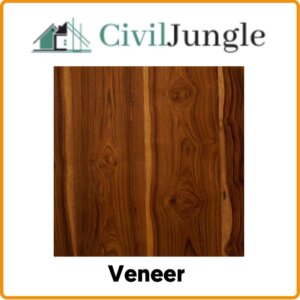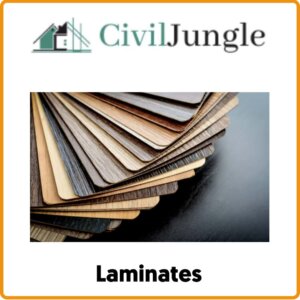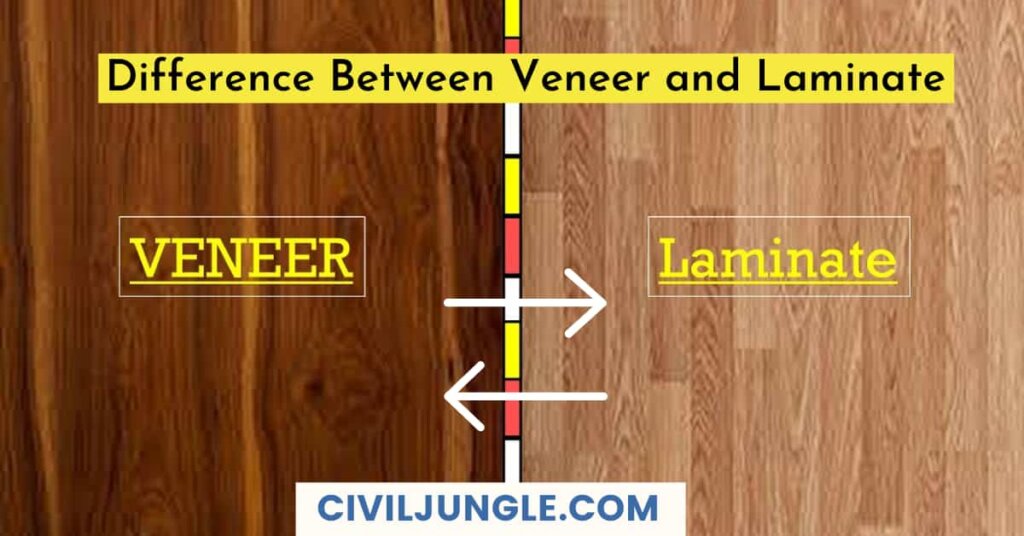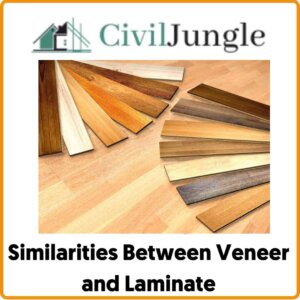What Is Veneers?
Important Point
They look like real wood since veneers are sourced from trees where every sheet of veneer has a unique appearance. No two sheets of veneer appear identical, unlike laminates.
Design of Veneers
The natural wood grain patterns offer a rich, warm and aesthetically pleasing appearance to the veneer sheets. In addition, veneers may be stained in various colours and finishes, such as gloss and matte.
Polishing of Veneers
One downside is that veneers are vulnerable to scratching over a period of time and the polishing peels off. However, the veneer surface can be sanded and polished to achieve its original appearance, much like wood.
Maintenance Service of Veneers
Since they’re not waterproof and could get affected by heat, veneers need periodic maintenance. In moisture-laden areas such as kitchens and bathrooms, veneer finishes must therefore be prevented as moisture can make its way there under the veneer and lose the upper surface. Remember that a layer of melamine will make the layer of the veneer waterproof.
Also, read: Difference Between One Way Slab and Two Way Slab | What is Slab
Environment-Friendly Veneers
Since these are generated from either a resource that is renewable, veneers are sustainable. Laminates, though, include plastics and resins that can end up over a period of time in landfills.
Costs of Veneers
Although veneer sheets are crafted with thin layers of real wood, these are more expensive than laminate finishes produced by the manufacturer.
What Is Laminates?
It is possible to classify laminates into the most preferred high-pressure laminates or HPL and less robust low-pressure laminates or LPL laminates. A decorative print or colourful sheet, which is finished with a plastic coating that gives the laminate a glossy look, is the topmost layer of each sheet.
Very Robust Laminates
Laminates are highly durable, resistant to stains and heat and are waterproof. This makes laminates highly suited to busy areas that are prone to a lot of wear and tear, such as kitchens, bathroom cabinets and children’s bedrooms. Nonetheless, laminates are susceptible to chipping and cracks and can not be fixed until affected.
Maintenance of Laminates
In contrast to a veneer finish, laminates are simpler to preserve since they can maintain their appearance for several years. Wiping the layer with a wet cloth as well as soapy water is part of the regular cleaning and maintenance of a laminate finish.
Designs of Laminates
In a large number of colours, designs and finishes, laminates are accessible. One of the main benefits is that natural materials such as stone, wood, leather, natural silk and so on improve the look and feel. Flame retardant, as well as antibacterial finishes, also are present in some of the new varieties of laminates.
Verdict of Laminates
Then go for a veneer finish if you prefer natural materials and the timeless look and warmth of real wood. For a modern and colourful interior that is easy to maintain, laminates are best suited.
Also, read : MDF vs Plywood | What Is MDF | What Is Plywood
Laminate and Veneer
1. Material of Veneer and Laminate
- Veneer: The veneer is a natural material.
- Laminates: Whereas laminate is a substance of artificial origin.
2. How Veneer and Laminates Are Manufactured
- Veneer: A veneer is a very thin wood slice obtained from a tree log, which is why it is also known as wood veneer because it is actually wood slices. Its construction is similar to laminate, with the primary difference being that real solid wood is made of the outer layer of veneer.
- Laminates: The laminate is created by pressing thin layers of flat paper and plastic raisins together. A decorative pattern or color is imprinted on the upper layer. It is like a picture of wood that is usually MDF or particleboard bonded to a less expensive wood-composite.
In India, individuals often referred to sun mica as laminate, which is actually the name of the well-known laminate company that was an early entry on the Indian laminate market.
3. Durability of Veneer and Laminate
- Veneer: As they are quick to scratch, veneers are usually not as durable as laminates and require maintenance and care.
- Laminates: Laminates are known to withstand scratches and stains due to their toughness.
4. Varieties of Veneer and Laminate
- Veneer: There are only a few veneer types that each serve a specific purpose. Raw veneers, paper-backed veneer, phenolic veneer, backed veneer, lad up the veneer, reconstitute veneer, woo on wood veneer are the types of veneers. Since the veneer is a natural material, a limited number of shades are available.
- Laminates: Whereas in a variety of colours, shades, designs, patterns & textures, laminates are available. They can be categorized generally into texture, high gloss, soft and matt. Some digital printers often produce custom prints on a board
5. Aesthetic and Look of Veneer and Laminate
- Veneer: Furniture with veneer looks like wood. This uses the aesthetic appearance of furniture and makes it look high-end.
- Laminates: While laminates have a synthetic feeling attached to them, synthetic wood lacks the natural feel and variety.
6. Water Effects of Veneer and Laminate
- Veneer: In the presence of water, a veneer is vulnerable to damage, as water is known to damage the polish and ultimately the wood surface.
- Laminates: Whereas, to a certain degree, laminates can resist water.
Also, Read: H-Beam vs I-Beam | What Is H-Beam | What is I-Beam
7. Lifespan of Veneer and Laminate
- Veneer: Veneer will last longer than laminate if timely polishing and proper care are taken. But laminates only last until they do not harm the top layer.
- Laminates: The entire surface needs to be replaced until the upper layer is worn out.
8. Utilizations for Veneer and Laminate
- Veneer: Since the ad artistic quality and unique appearance, a veneer could be used in lavish interior design walls etc. in the meeting room.
- Laminates: For kitchen cabinets, wardrobes, tabletops, office furniture, doors as well as other commonly used furniture, laminates are the perfect option.
9. Eco-Friendly Veneer and Laminate
- Veneer: Veneers are a sustainable resource and they go far in replacing solid wood applications economically.
- Laminates: Whereas sheet laminates include plastics and resins. Any of the resins emit damaging gases.
10. Recyclability Veneer and Laminate
- Veneer: It’s possible to recycle the veneer.
- Laminates: Whereas laminates are difficult to recycle.
11.Scratch & Abrasion for Veneer and Laminate
- Veneer: As compared to laminates, veneers have less resistance to abrasion and scratches.
- Laminates: The surface of the laminate is strong and resistant to scratching and abrasion.
12. Toxicity of Veneer and Laminate
- Veneer: A natural material is a veneer and it is non-toxic.
- Laminates: But laminate is toxic because VOC is known to emit (Volatile organic compound).
13. Installation of Veneer and Laminate
- Veneer: Special skills, tools and adhesives are needed to install veneers. It is not possible to mount it on any existing floor.
- Laminates: Though laminates are simple to install, there is no need for special expertise and equipment. Any existing surface can be built over it.
Also, Reda: What Is Inverted Beam | Advantages of Inverted Beam | Purpose of Inverted Beam
14. Re-Polishing of Veneer and Laminate
- Veneer: The surface may be sanded and repainted to cover warps or tears if the veneer depends on the thickness of the polish applied.
- Laminates: But it is not possible to paint or re-polish laminates.
15. Substitute of Veneer and Laminate
- Veneer: Veneer sheets are special sheets that are broken, never eligible for identical replacement.
- Laminates: But in the case of laminates, if needed, similar-looking sheets can be made.
16. Maintenance Service of Veneer and Laminate
- Veneer: The veneer required more maintenance compared to the laminates. To preserve their elegance, they need to be polished from time to time.
- Laminates: Yet laminates are simpler to protect. They are scratch-resistant, waterproof and typically maintain their year-round look.
17. Usable Thickness of Veneer and Laminate
- Veneer: The usable thickness for the veneer is 0.4 to 6 mm.
- Laminates: Whereas, from 0.6 mm to 18 mm, laminates are available.
18. Costs of Veneer and Laminate
- Veneer: Veneers are typically priced higher than alternate laminates and, relative to laminates, their maintenance cost is also high.
- Laminates: But as opposed to veneers, laminates are typically pocket-friendly and more affordable. The price of laminates depends on the brand and quality. The laminate repair cost is negligible.
Also, Read: What Is Slab Beam / Hidden Beam / Concealed Beam | Advantage and Disadvantage
19. Similarities Between Veneer and Laminate
Veneers Wood
What is wood veneer? Wood veneer is a thin slice of natural wood that is attached, through gluing or pressing, onto a panel of fiberboard or particleboard. In furniture, wood veneers give the appearance of an all-wood piece, when in reality only the surface is taken from natural wood.
Water Damaged Veneer
This is a gorilla glue any kind of wood glue will work however. But i like this one because it’s the color of the wood anyway. When it dries it’s kind of an amber color. So.
Veneer Hub
You’ll want to overlap and double cut all your seams with a razor blade lightly dampen the back of three sheets of wall covering with a cellulose. Sponge.
Lace Wood Veneer
Lace wood veneer is a highly renewable species. It is light pink with a silvery sheen, and has patterns of small to large rays. Leopardwood veneer has the same grain pattern as lace wood, however, the color is much darker. The species is also known as silky oak veneer and Brazilian lace wood veneer.
Engineered Veneer
It is a complete program: tenderized sheets, thin edge banding, thick edge banding and panels. It is the perfect product for projects requiring uniformity of look, without random natural characteristics.
Best Wood Veneer
- $35.47 Aaa Flat Cut Tineo Veneer Sheet.
- $41.06 Aaa Karelian Birch Burl Veneer Sheet.
- $36.86 Aaa Marbled Zebrawood Veneer Sheet.
- $30.96 Aaa Marbled Zebrawood Veneer Sheet.
- $56.37 Aaa Marbled Zebrawood Veneer Sheet.
- $118.49 Aaa Pommele Eucalyptus Veneer Sheet.
- $47.39 Aaa Quilted Maple Veneer Sheet.
Mindi Wood Veneer
Mindi wood possesses properties that make it naturally resistant to fungi and decay. It is preferred by cabinetmakers and woodworkers because it is very easy to work with. When compared with other types of wood, it shrinks less and dries quickly. These qualities make it an ideal choice as a base for veneers.
Padauk Veneer
With a typically straight grain, african padauk’s texture is open and coarse, with a natural lustre. Resistant to termites and other insects, african padauk is a very durable wood with exceptional rot resistance. Very easy to work with, it finishes, glues, and turns very well.
Finishing Veneer
Water based polyurethane varnish is a good choice for finishing wood veneers. It dries quickly and it gives a lasting, durable, finish that resists stains, abrasion, water marks and some chemicals. The clean up is with water, there are little to no fumes, and you can work in a closed area.
Oak Wood Veneer
A veneered product is made out of thin, decorative slices of high quality oak, affixed to a lower density core that will resist warping and moisture and therefore offer a good value alternative to solid oak. They can also be stained to produce a warm, rich finish.
Which One Is Better Laminate or Veneer?
Laminates are known for their durability and reliability. Since it looks like wood, and you stick it to a composite base, it is extremely durable and resists scratches and stains. Veneer: Veneers are usually not as durable as laminates. They require maintenance and care since they are prone to scratches.
How Can You Tell the Difference Between Laminate and Veneer?
The main difference is that veneers comprise thin layers of wood that are pressed on a plywood base while laminates are manufactured by pressing together layers of flat paper and plastic resins under high pressure.
What Are the Different Thickness of Laminate and Veneer?
The thickness available in veneer is 0.4 to 6 mm. Whereas laminates are available from 0.6 mm to 18 mm.
How Can You Tell If Furniture Is Veneer?
If the underside of the furniture you are inspecting has a grain that looks completely different than the top, then it’s a veneer. Top and bottom veneer pieces are made from two different pieces of wood, meaning they won’t match.
Is Laminate Waterproof?
Laminate flooring is an affordable way to elevate the look of any room in your home. But even with all these advantages, laminate flooring usually isn’t waterproof, making it more prone to warping, rotting, and bending. So how can you prevent your laminate flooring from warping, rotting, and bending.
Is Veneer Flooring Good?
Like traditional hardwood, engineered veneer flooring is strong and durable, and it can typically endure humidity changes in your home. It has an attractive wood look, with different surface treatments, colours, and designs to choose from – with an option to match just about any type of traditional hardwood.
Is Veneer Expensive?
Generally, dental veneers range in cost from as low as $400 to as high as $2,500 per tooth. Composite veneers are the least expensive veneer option, generally ranging from $400-$1,500 per tooth, whereas porcelain veneers generally cost between $925 to $2,500 per tooth.
Is Veneer Good for Bed?
Wood veneer gives you the same look, feel and beauty as solid wood with unique variations in grain, colour and texture. This versatile bed frame will look great with your choice of textiles and bedroom furniture.
Is Laminate Furniture Durable?
Compared to solid wood options, laminate furniture is much more stain and scratch-resistant. The manufacturing process creates an incredibly durable product that can withstand a demanding work environment. When it comes to affordability, laminate furniture offers great value.
Like this post? Share it with your friends!
Suggested Read –
- What Is Dry Pack Mortar | Advantages of Dry Pack Mortar | Disadvantages of Dry Pack Mortar
- What Is Caisson Foundation | Types of Caisson Foundation | Advantage, Disadvantage, Application, & Construction of Caisson
- What Is Hempcrete | Hempcrete Blocks | Advantages & Disadvantages of Hempcrete Blocks | Applications of Hempcrete
- What Is Hard Hat | Hard Hat Colour Definition | Different Hard Hat Colour Codes | Types of Safety Helmets | Classification of Hard Hats
Originally posted 2022-02-17 13:56:33.








Leave a Reply